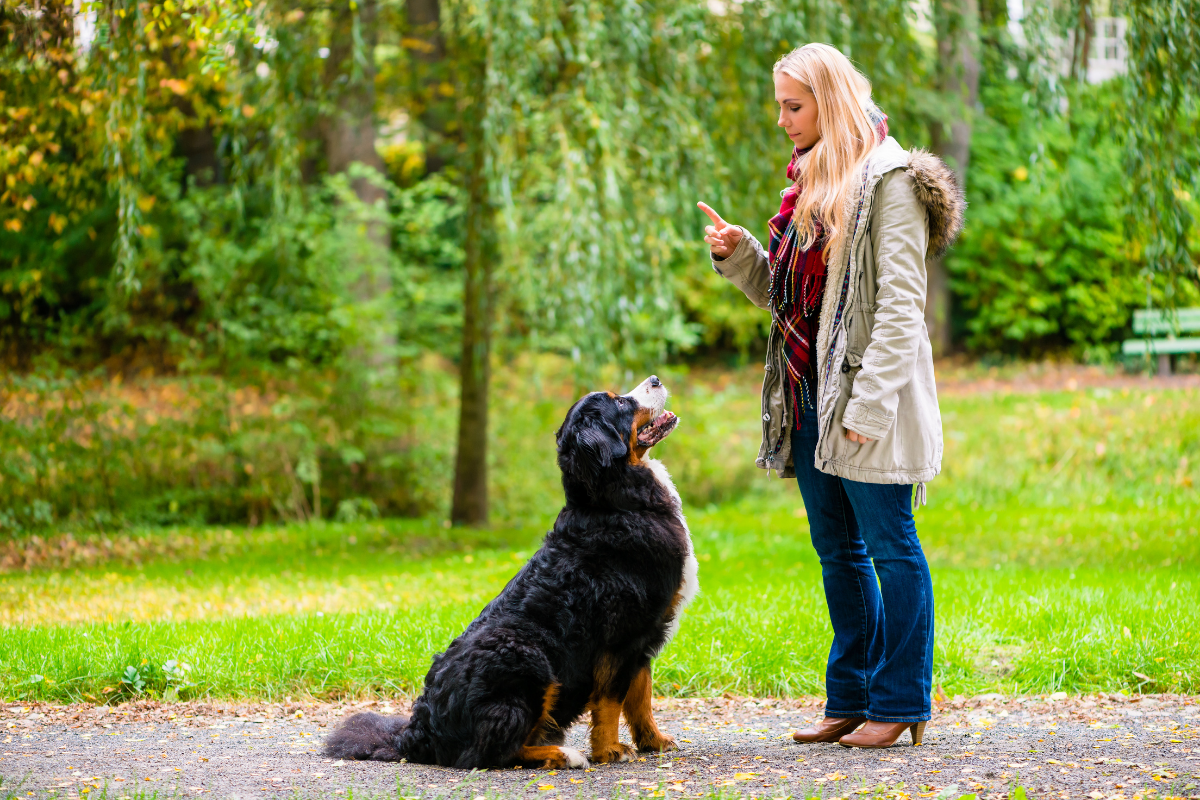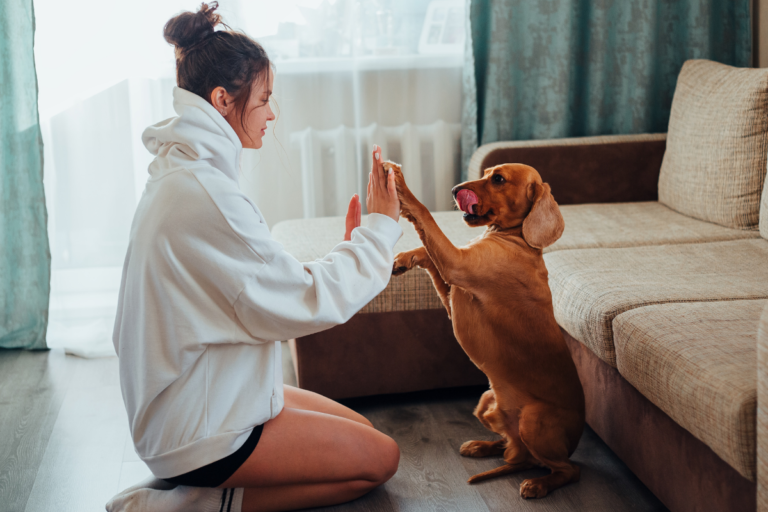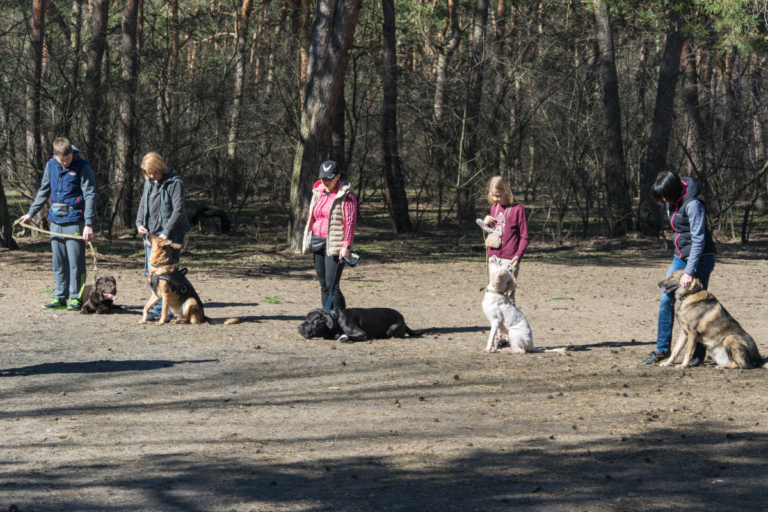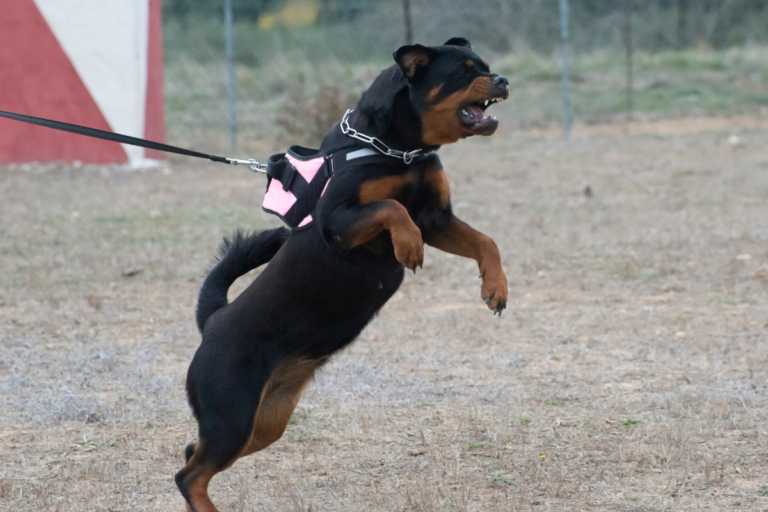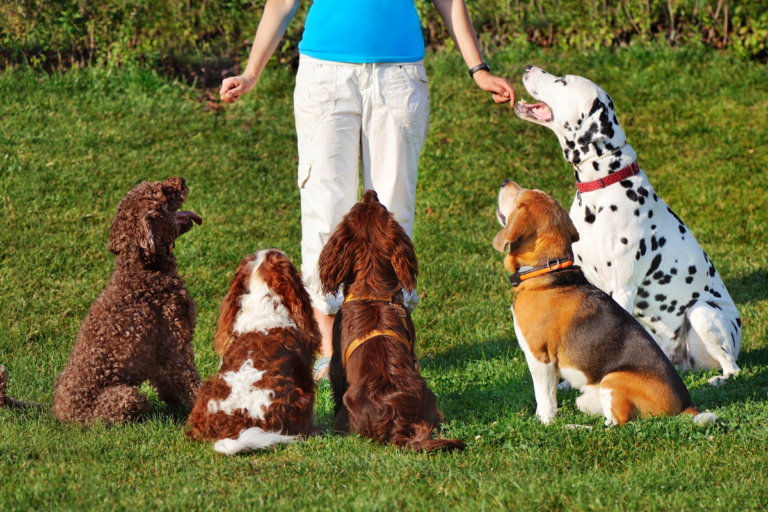Sit with Love: Positive Reinforcement Methods for Teaching Your Dog to Sit
Teaching Your Dog to Sit
Getting our pups to sit is like nailing the ABCs of dog training. It’s the starter pack for all those fancy tricks and makes sure our doggo doesn’t act like a total goofball in public.
Why the Sit is a Big Deal
Here’s why telling your dog to park its rear is super handy:
- Follow-the-Leader: It’s the building block for other tricks.
- Bad Manners Bouncer: A dog that sits isn’t bouncing off the walls or slobbering on guests.
- Life Saver: It keeps them from darting into traffic like a daredevil.
- Chaos Control: Keeps them chill when they get overexcited or there’s too much going on.
Whether your dog’s a baby furball or a more mature mutt, nailing this command is a must-must. It’s like the heart-to-heart between you and your pup.
Tricks to Get Your Pooch Sitting
There’s more than one way to get the sit thing down. It’s all about what clicks for your four-legged pal.
The Lure Trick
For the lure trick, use a tasty treat or a fun toy to lead your dog into the right move. Most people find this method a breeze when starting out.
- Dangle a treat right in front of their sniffer.
- Slowly guide it up. Their head goes up, booty goes down.
- As soon as their butt hits the ground, shower them with treats and cheers.
Step-by-Step
Think of it as a slow dance of giving rewards for the little strides toward the sit (The Other End of the Leash).
- Catch them in the act, like a detective.
- Reward pronto with lots of love and a treat.
- Get them used to plopping down by shaking treats as they get closer.
Spontaneous Recognition
This is like catching a kid being good and giving them a candy (Training Your Dog and You).
- When they sit on their own, out of the blue.
- Dish out a reward and say “sit” with your excited voice.
Mix and Match
Sometimes you gotta mix up tricks, like luring them first and then recognizing them when they do it naturally. The switch-up keeps them on their toes and helps them get it faster.
Where the Magic Happens
Where you practice can make or break your training (Performance K9 Training).
| Spot | How Well It Works |
|---|---|
| Quiet Room | Top Notch |
| Backyard | So-so |
| Dog Park | Slippery Slope |
Kick things off where it’s boring, like indoors or the yard. Once your dog’s getting the hang of it, try changing up places to see if they can sit and stay in a wild setting like the dog park.
Cracking the sit code and using the right tricks (Pettable) makes the sit training stick. For more tips on getting your pup to mind its doggy manners, check out our other stories on k9 dog training and puppy training classes.
Understanding Dog Training Consistency
Benefits of Consistent Training
Hey, it’s all about teaching our pups those must-know commands like “sit.” But what’s the secret sauce? Yup, you guessed it—sticking with it. Let’s chat about why showing up day in and day out makes all the difference.
- Solid Habits: When we keep it consistent, our dogs learn what to do without even having to think about it. The habit becomes as natural as wagging their tails when they see you hitting the fridge. It’s about having a well-mannered dog who’s in sync with us for life.
- Trust Building: Consistency is like a comfort blanket for dogs. When they know their actions lead to familiar results, they feel safe, and our bond gets stronger.
- Clear as Day: Changes in the playbook can make things messy. Dogs need things to be straightforward, and irregular cues can throw them off their game.
- Routine is Key: Sticking to the same signals, making sure everyone’s on board with the game plan, and fairly doling out rewards when deserved keep things grooving smoothly.
- Speaking Their Language: Dogs get us best when we keep the training clear and steady. Mixing things up can confuse our four-legged learners and make them unreliable in following through.
Want to step up your game? Check out some dog training classes that make consistency their breadcrumb trail.
Establishing Trust through Consistency
So, how do we build unshakable trust with our canines? It’s all about keeping things consistent. Have a look at how this works wonders for bonding:
- Predictability Jive: When everything’s a routine, trust blossoms. Knowing what to expect gives our furry pals peace of mind and strengthens our bonds big time.
- Close Connection: With a steady hand, we’re telling our dogs exactly what we need from them. This clarity makes them feel secure, and while they’re more at ease, we’re the pack leaders they happily follow.
- Less Stress: Dogs feeling in the know about what’s expected have less to worry about. They’re cool and collected, knowing security’s always there.
Being consistent isn’t just about looking good— it’s the foundation of the trusting relationship we need with our dogs. Want to know more on building this trust? Check out our puppy training classes to get started early.
With dependable training methods in our toolkit, we’re set for not only nailing those commands but also paving the way for a warm and loving bond with our furry pals. Looking to dive deeper? Swing by our guide on perfecting the sit command for more tips and tricks.
Sit Command: A Fun Approach for Relaxed Pooches
Ready to turn the “sit” command into a tail-wagging success? Let’s check out some strategies that’ll make training as fun for us as it is for our puppers.
Fun, Effective Techniques
Teaching our dogs to sit doesn’t have to be a chore. Here are some tried-and-true tips:
-
Lure ‘Em with Love: Grab a treat or fave toy, and guide your pupper’s bum to the floor. It’s like magic for many pet parents (PreventiveVet).
-
Gentle Paws-On Approach: Gently nudge your fur pal’s rump down. Works wonders for some, but tread lightly – we want cooperation, not confusion.
-
Step-by-Step Rewards: Celebrate every little step towards sitting. Encourages our clever pups to figure it out on their own (Training Your Dog and You).
-
Click, Treat, Repeat: Capture that perfect sit with a clicker. Hands-off, but make sure your timing’s on point! (PreventiveVet)
-
Actions Speak First: Show them what you want with gestures before saying “sit”. Once they get it, introduce the magic word. (Training Your Dog and You)
| Method | What You Do | Why It Works | What to Watch For |
|---|---|---|---|
| Luring | Use treats as guides | Super simple | Pupper greed |
| Gentle | Gently guide them down | Direct approach | Can confuse pups |
| Rewards | Reward mini milestones | Inspires creativity | Needs patience |
| Clicker | Click to mark sitting | Hands-free | Precision needed! |
| Gestures | Use hand signs | Clear talking | May need extra time |
Setting the Stage for Success
Creating a chill training scene makes all the difference. Here’s how we can keep it cool:
-
Keep It Calm: Find a peaceful spot. Our pups learn best when they’re cool as cucumbers.
-
Be Crystal Clear: Use the same gestures and words. Start with hand signs, then add “sit” when they’re ready (Training Your Dog and You).
-
Praise Positivity: Every sit is worth a cheer – or a treat. Check out our nod to Positive Puppy Power.
-
Keep It Quick: Make it snappy – 5-10 minutes tops. Short and sweet keeps boredom at bay.
-
Play Time Breaks: Let them have a blast between sessions. Learning should be like fetch – fun and carefree.
-
Up the Ante: Sneak in mild distractions and see if Fluffy can stay put. Builds self-control and focus.
Curious about something more structured? Our puppy school offers a helping paw. Mix up the methods and environments, and watch the magic unfold as we teach our best buds to sit and stay like champs!
Optimizing Sit Command Training
Using Positive Reinforcement
Using a bit of positive reinforcement when training your dog is like having a secret weapon. To teach them to sit, reward every good move with treats, praise, or playtime. It works wonders! Treats like chicken or cheese can really grab your furry friend’s attention during lessons. Every time your pup sits when told, it’s high-fives all around with a goodie or a pat on the head! Dogs love feeling like rock stars with the right kind of cheerleading.
The trick is in the timing—don’t wait! Reward them as soon as that cute butt hits the floor. When saying “yes,” make sure to do it right when they get it, or else they might get a bit confused. Miss the mark, and they’ll be more puzzled than a cat at a dog park!
| Action | Reward Type | Example |
|---|---|---|
| Sits on cue | Treat | Tasty treats like chicken or cheese |
| Stays put | Verbal Praise | A quick “Nice work!” as soon as they sit |
| Locks eyes after sitting | Toy | Their favorite toy for extra fun |
For more paw-some tips, check out our area on dog training classes.
Wrapping Up Training Sessions
Finishing a lesson on a high note is super important. Even if you feel like things are moving at a snail’s pace, end with a little success. Choose something easy for your dog, give them some loving quickly after that. They’ll leave on a high note, tails wagging.
Sessions shouldn’t drag on; 10 to 15 minutes is just right to keep your dog interested and happy. Too long, and you’re just asking for a sleepy and disinterested pup. Just like humans, each dog has their own routine. Some do better with shorter, more frequent sessions.
Keep the training straight and to the point—consistent treats, consistent commands. Switching things up too much just confuses them and might send behavior off the rails. Getting the whole family involved ensures everyone’s on the same page, using the same cues.
| Training Focus | Suggested Method |
|---|---|
| Time spent | 10–15 minutes |
| Uniform commands | Stick to the same words and hand gestures |
| Consistent treats | Start with high-value rewards, then phase them out |
Taking a peek at easiest dogs to train can give you an extra boost with your training playbook.
For more ways to keep your sessions upbeat and effective, check out settings for group of dog training and insights at blue dog training.
